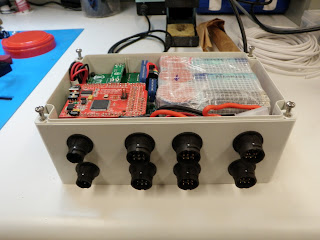This year we are moving our batteries inside a waterproof (IP67+) box along with the electronics. All of the connections are made through circular connectors which have sealing glands around the wires and face seals. They're also made of plastic and quite light.
 |
| Electrical box with circular connectors installed and motor driver board in place |
Another change this year has been to change the communication from the main controller to the motor controllers to I2C. This change allows for easy expansion. If we ever needed more motors we just add another board to the stack. Right now we can control 4 motors using PID loops with quadrature feedback. The motor drivers are rated to 12A without heatsinks and can operate up to 16V (we run at 12V). There are two Arduino pro minis on the board and each one is responsible for two motors. This division allows you to actually expand the system two motors at a time. The motor controllers provide current feedback which we use to limit the torque output (so we don't break the boat when something jams). The best part is that all the code is updated too and it works. Check out the repo here.
Stay tuned for more updates as we ramp up this week getting ready for first sea trials as the ice is off the lakes now!
 |
| Yeah, It's a tight fit |

Beauty! You guys must play a mean game of Tetris.
ReplyDeleteEasily, the article is actually the best topic on this registry related issue. I fit in with your conclusions and will eagerly look forward to your next updates. pometalni stroji
ReplyDelete